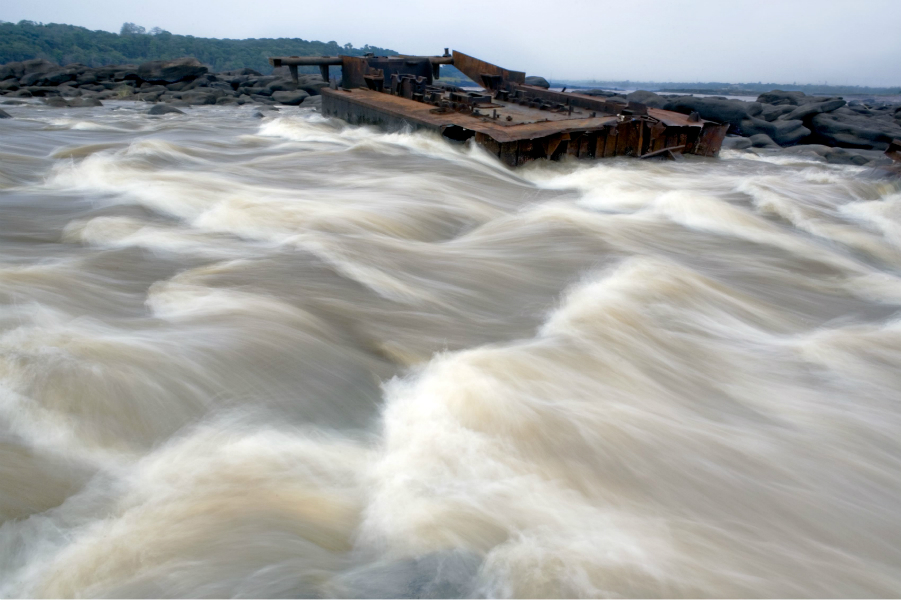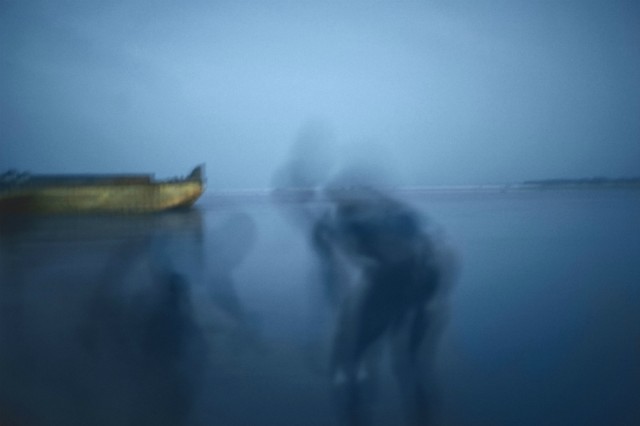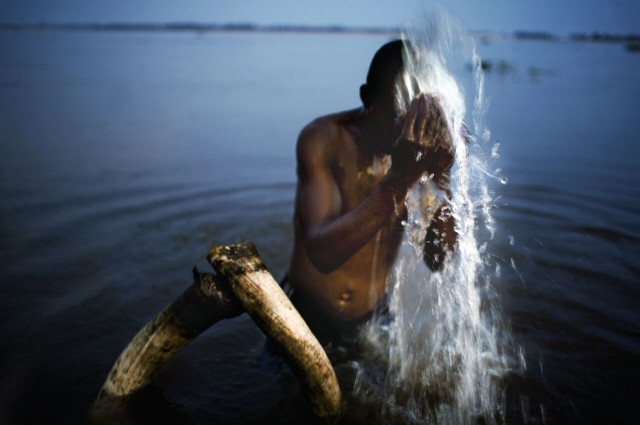“In Africa suffering is a source of misery, but also a form of survival”: Nyaba Ouedraogo, The Phantoms Of The Congo River

James West speaks to contemporary photographer Nyaba Ouedraogo about how (and why) his new exhibition is juxtaposed with museum objects taken from the Congo area during British colonial rule, and the controversy of the ‘African aesthetic’…
“The river is where I come from”, remarks Nyaba Ouedraogo in a rich baritone voice. “The Congo is my origins. The river is me. The river is you.”
The Congo River runs through the heart of a new exhibition by West African photographer Nyaba Ouedraogo, which opens today at Manchester Museum. The show inaugurates the museum’s exciting new interactive study space on the regenerated top floor of its Alfred Waterhouse building. The Study represents the latest, and perhaps the most ambitious phase, in the museum’s continued revitalisation. The £700,000 project, which has been directed by Ben Kelly Design and overseen by learning and engagement manager Menaka Munro, provides a vibrant space to research, design and explore — including a social-media friendly digital microscope, and an ‘aquaponic’ mint farm.
However, while The Study represents a bold step into the Museum’s future, Ouedraogo’s The Phantoms of the Congo River is also a nod to its past. Ouedraogo describes it as “both a ballad to, and a deconstruction of” Joseph Conrad’s brooding 1899 novella Heart of Darkness, which documents an ill-fated trading voyage into the heart of the Congo Free State.
The Phantoms of the Congo River juxtaposes Ouedraogo’s photography with elements of the museum’s own West African collections, many of which were first received at the height of British imperialist advances into Africa around the turn of the 20th century. “We are a Victorian institution,” acknowledges Stephen Welsh, Manchester Museum’s curator of living cultures. As such, the inclusion of elements of the museum’s own collection offers an attempt to confront its chequered history.
Welsh explains: “We opened in the late 19th century. The African and Congolese collections you can see on display fit perfectly in to the narrative which runs throughout Nyaba’s exhibition, which is one of colonial exploitation and imperialism. The types of objects you see here – ivory, various metals and precious natural resources, the things that European imperialists wanted to consume and control – resonate with the very contemporary issues at the heart of Nyaba’s photography.”

This desire to control, and the violence which frequently accompanies it, are crucial to Conrad’s work. Ouedraogo recalls that Heart of Darkness left him traumatised upon first reading. “I shut the book and put it down and left it there for six months.” Yet when he returned to the text, he saw the opportunity to take Conrad’s writing, and to remake and reshape it into his own narrative of the Congo.
“Conrad’s book showed the extreme violence, the suffering of the people who lived there under colonial rule;” Ouedraogo continues. “But I see a lot of life there, I was hypnotized by the river, by its vitality and its potential.” The result is an exhibition which reminds us of the enduring legacies of colonial rule, and the continued impact of economic and political corruption, yet which also offers a tribute to “the rich history of the people who live on the Congo’s banks.”
Central to this vision is Ouedraogo’s understanding of his work as a form of “photographic poetry.” He describes this idea as foregrounded in a uniquely African point of view. “How I see and understand the world is rooted in an African aesthetic. It’s not so much about the technical elements of my photography as it is about myself, my own feelings, my experiences as an African person, and how Africa belongs to me.” This term is a heavily loaded one, particularly within the context of both Western and Afrocentric scholarship. Researchers and writers from Chinua Achebe to Robert Farris Thompson have grappled back and forth over the intuitive and symbolic nature of African art.
For Ouedraogo, this is more a statement of personal experience. “The question of an African aesthetic has been around for a long time, and some people really don’t agree with it, but for me it is about taking pictures in an African way, in a way that speaks to the Africa that I see around me.”

Whilst Ouedraogo’s understanding of “photographic poetry” is focused more on aesthetic than technique, his work carries a number of characteristic traits. Perhaps most notable is his use of composition through long exposures and soft focus, which helps to evoke the ‘Phantoms’ of his exhibition’s title. This ethereal quality is applied to both human subjects, in photographs such as Les Trois Baigneurs du Flueve Congo (The Three Bathers of the Congo River), but also to the river itself, through pieces such as Esprit de Fleuve (Spirit of the River). Other photographs continue the activist role Ouedraogo has taken up through earlier exhibitions such as The Hell of Copper in 2008, which led to him being shortlisted for the Prix Pictet, an international award in photography and sustainability.
The Hell of Copper documented the lives of young Ghanaians scavenging copper wires from Aglobloshie Market, a suburb in Accra which has become a major destination for the illegal dumping of electronic waste from Europe and the United States. “The planet and its citizens live through electronics,” declared Ouedraogo several years ago. “Now people must understand the injustices and the sad environmental and human consequences of our global electronic economy.”
Similarly, photographs such as Work, Le Portrait de Mobutu and Lord of War provide their own commentary on the continuing economic, political and military turmoil which affects the lives of many West Africans. This is particularly true for Africans in the Republic of the Congo and the Democratic Republic of the Congo, whose borders are defined by the banks of the river.
The Second Congo War, which officially ended in 2003, but which continues to rumble on through localised conflict in provinces such as Katanga, was the deadliest war in modern African history. In his 2001 Pulitzer Prize winning expose on the conflict, Paul Salopek described how “the mighty Congo River, curving like a giant scythe through the battle zone, often conspires to hide the dead.” In a literal sense, perhaps these are the ‘Phantoms’ Ouedraogo seeks to represent. “In Africa suffering is a source of misery, but also a form of survival”, he muses, looking at the spectral figures which populate some of his photographs.
Yet Ouedraogo’s photographs are structured around oppositions – “violence and peace, or light and dark.” Accordingly, whilst the river provides many with an end, it also brings the promise of new beginnings. When I ask Ouedraogo to pick out one image which best surmises his work, his attention immediately turns towards La Vie (Life). The image presents a young man wading out into the river towards the lights on the opposite bank, carrying his own candle to illuminate the murky water which surrounds him. Ouedraogo explains that the image is steeped in imagery. “The water is the womb from where the child is born, the white symbolises death, the light is an image of humanity. We come from the river, and the river takes us home.”
James West
See Nyaba Ouedraogo’s The Phantoms of the Congo River exhibition at The Study, Manchester Museum, from today until 10 April 2016 — free entry
The Study is now open: Manchester Museum’s brand new hands-on, public gallery, research space, and co-working centre: read more in our Studio Series here
Follow Manchester Museum on Twitter @McrMuseum
Read James West on Exposing The Congo and Black Gold And Delta Blues





